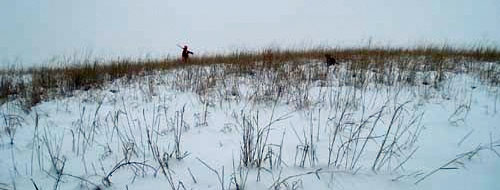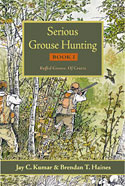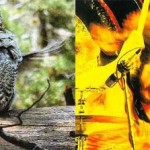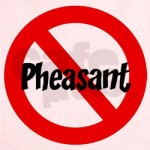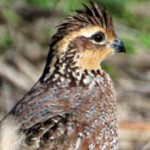Bird Forecast Roundup: MI, NE, MT
It’s not every state or every species yet, but some info is trickling out. Here’s the skinny on three big bird states.
Michigan: Good for Ruffs
First off is Michigan, where it’s looking good according to this article. Highlights:
> Michigan’s grouse season looks promising this fall because spring started about two weeks early this year, Stewart said [Al Stewart, the upland bird specialist for the Department of Natural Resources and the Environment]. It was generally warmer and more dry than usual during the peak nesting season in May and early June when grouse chicks are most vulnerable to adverse weather.
> It helps that Michigan’s grouse populations may be at the top of their 10-year population cycle this year, Stewart said. Grouse populations go up and down in basically 10-year cycles for unknown reasons. “We have been anticipating that Michigan’s peak grouse populations would be seen in 2009 and 2010 and that may still be true,†he said. “We may be past the peak, but the bottom line is that we are still in the upper end of the peak.”
> Michigan’s grouse season opens Sept. 15 with the rest of the state’s small game season, but the woodcock season does not begin until 10 days later on Sept. 25.
> Stewart, who is an avid grouse and woodcock hunter himself who spends as much as 30 days every fall hunting those gamebirds, said bird hunters should concentrate on finding birds in thick aspen stands near water in September and early October. Look for wild raisin or autumn olive shrubs in the same vicinity…. The aspen should be about the size of your wrist…about 10 to 12 years old.
> Later in early to mid-October, hunters should concentrate on areas with lots of gray-stem dogwood… Later still, hunters should be looking for find birds near stands of crabapple trees…. When the snow flies in December, hunters should find birds in thick aspen stands with edges of tag alders. Look too, Stewart said, for mature trees covered with wild grape vines that are another favorite grouse food.
> Stewart said the best time to pursue grouse is between Oct. 16 and Oct. 31, when the flush rates are at the highest…. The peak woodcock flush rates are between Oct. 1 and Oct. 15.
Nebraska: So-So Overall
Here’s what Nebraska’s Upland Game Forecast (PDF) says:
Pheasants
> Severe winter weather in parts of Nebraska and above average rainfall this spring impacted pheasant populations in parts of the state. Statewide, however, the pheasant abundance index was similar to 2009…. Increases in abundance were observed in the Sandhills and Southwest districts [a “pheasant boundary map” is in the above PDF]. Abundance was similar to 2009 in the Central pheasant region, but declines were noted in the Northeast, Panhandle and Southeast regions.
> Pheasant abundance appears to be high again this year in the Southwest region, which, combined with public access, offers excellent opportunities for hunting.
Bobwhites
> Bobwhite populations in the core areas of their range in Nebraska experienced prolonged periods of deep snow cover, ice and freezing temperatures. Above-average rainfall and localized hail storms occurred during the breeding season as well. These severe weather events negatively impacted populations. Abundance indices…were lower in all bobwhite regions except for the West Platte.
Prairie Grouse (Sharptails and Prairie Chickens)
> Sharp-tailed grouse abundance indices were lower in 2010 compared to 2009 on four of seven breeding ground survey routes completed in the Sandhills. Prairie chickens had lower abundance indices on eight of 10 routes completed in the Sandhills and Southeast.
> Data collected indicated a modest statewide increase in prairie grouse, with the largest increases occurring in the Northeast, Panhandle, and Southwest regions Decreases in abundance were noted in the Sandhills and Southeast regions, similar to results of the breeding ground survey. Biologists indicate that the best areas for grouse will be west of Bassett, where winter conditions were milder.
Montana: Bummer
Looks like in Montana it’s not so great…info is from this article in the Great Falls Tribune.
> “There is no doubt that this spring’s cool, wet weather kept things interesting. Fortunately, in many parts of the state, the temperatures were not so severe as to wipe out this year’s production,” said Rick Northrup, Montana Fish, Wildlife & Parks gamebird coordinator.
> But Northrup said the bad weather in late May and early to mid-June, affected grouse and pheasants in northwest Montana, in north-central Montana and the western portion of FWP Region 6. “In these areas, upland gamebird hunters in general can expect to see gamebird numbers similar to or lower than last year’s,” Northrup said. “Moisture and cool temperatures generally tended to be less of a concern in other portions of the state, although there are going to be local exceptions.”
> He said deep snow during late April and early May in Judith Basin and eastern Cascade counties, extending into Choteau and Fergus counties may have been particularly harsh on adult pheasants and gray partridge.
> From where I hunt, last year’s season appeared to be pretty grim. Saying that this year will be about the same or worse gives me nothing to crow about. We don’t have long to wait to see what this fall’s bird hunting looks like. All upland game birds but pheasants are fair game come Sept. 1. Pheasant season opens Oct. 9.
Category: 2010, Forecasts/counts, MI, MT, NE, Northern Bobwhite, Pheasants, Prairie Chickens, Ruffed Grouse, Sharptailed Grouse, Woodcock

